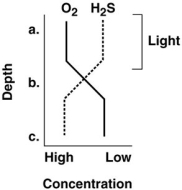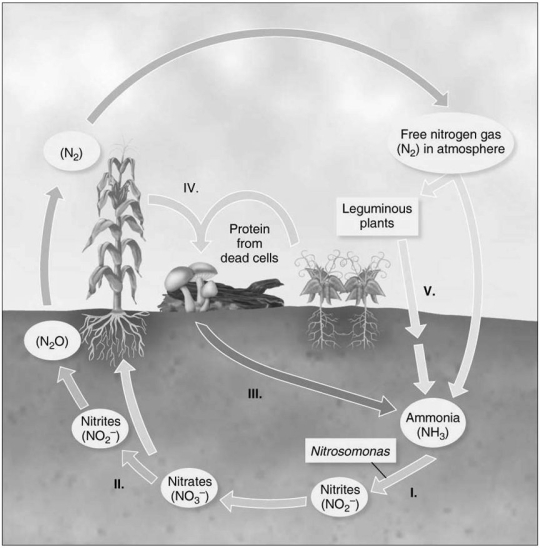A) cyanobacteria
B) mycorrhizae
C) lichens
D) Rhizobium
E) Azotobacter
G) A) and E)
Correct Answer

verified
Correct Answer
verified
Multiple Choice
NH3 → No2-
A) takes place under anaerobic conditions.
B) takes place under aerobic conditions.
C) The amount of oxygen does not make any difference.
E) None of the above
Correct Answer

verified
Correct Answer
verified
Multiple Choice
Figure 27.2
 -Where are photosynthetic bacteria most likely to be found in Figure 27.2?
-Where are photosynthetic bacteria most likely to be found in Figure 27.2?
A) a
B) b
C) c
D) a and b
E) b and c
G) A) and C)
Correct Answer

verified
Correct Answer
verified
Multiple Choice
Figure 27.1
 -Nitrification is beneficial to farmers. It is represented by which step in Figure 27.1?
-Nitrification is beneficial to farmers. It is represented by which step in Figure 27.1?
A) I
B) II
C) III
D) IV
E) V
G) C) and D)
Correct Answer

verified
Correct Answer
verified
Multiple Choice
Which of the following requires aerobic conditions?
A) water treatment
B) sludge digestion
C) secondary sewage treatment
D) primary sewage treatment
E) nitrogen fixation
G) A) and B)
Correct Answer

verified
Correct Answer
verified
Multiple Choice
All of the following organisms are involved in carbon fixation EXCEPT
A) cyanobacteria.
B) mycorrhizae.
C) green and purple sulfur bacteria.
D) lichens.
E) algae.
G) A) and E)
Correct Answer

verified
Correct Answer
verified
Multiple Choice
Zoogloea form flocculent masses in
A) tertiary sewage treatment.
B) anaerobic sludge digestion.
C) water treatment.
D) primary sewage treatment.
E) activated sludge digestion.
G) A) and E)
Correct Answer

verified
Correct Answer
verified
Multiple Choice
In freshwater lakes and ponds, the majority of photosynthetic microbes are located in the zone(s) .
A) benthic
B) littoral
C) profundal
D) limnetic
E) benthic and profundal
G) B) and C)
Correct Answer

verified
Correct Answer
verified
Multiple Choice
Which of the following terms describes step III in Figure 27.1?
A) ammonification
B) nitrification
C) nitrogen fixation
D) denitrification
E) assimilation
G) All of the above
Correct Answer

verified
Correct Answer
verified
Multiple Choice
The release of phosphate-containing detergents into a river would
A) improve the water quality.
B) kill algae.
C) increase algal growth.
D) kill bacteria.
E) None of the answers is correct.
G) A) and C)
Correct Answer

verified
Correct Answer
verified
Multiple Choice
Biochemical oxygen demand is a measure of the
A) amount of organic matter present in a water sample.
B) number of bacteria present in a water sample.
C) amount of nitrogen in a water sample.
D) amount of oxygen present in a water sample.
E) amount of undissolved solid matter present in a water sample.
G) A) and B)
Correct Answer

verified
Correct Answer
verified
Multiple Choice
Figure 27.2
 -Where are the benthic microbes such as Desulfovibrio and Clostridium most likely to be found in Figure 27.2?
-Where are the benthic microbes such as Desulfovibrio and Clostridium most likely to be found in Figure 27.2?
A) a
B) b
C) c
D) b and c
E) a and b
G) B) and E)
Correct Answer

verified
Correct Answer
verified
True/False
The bacteriological safety of drinking water is determined by testing water samples for the presence of human pathogens.
B) False
Correct Answer

verified
Correct Answer
verified
Multiple Choice
Aerobic respiration occurs in
A) secondary sewage treatment.
B) tertiary sewage treatment.
C) anaerobic sludge digestion.
D) water treatment.
E) primary sewage treatment.
G) A) and B)
Correct Answer

verified
Correct Answer
verified
Multiple Choice
Adding untreated sewage to a freshwater lake would cause the biochemical oxygen demand to
A) decrease.
B) increase.
C) stay the same.
D) The answer cannot be determined based on the information provided.
F) B) and C)
Correct Answer

verified
Correct Answer
verified
Multiple Choice
In the ONPG and MUG test for fecal coliforms, a sample that is positive for E. coli will be
A) positive for ONPG; non-fluorescent in UV light.
B) positive for ONPG; fluorescent in UV light.
C) negative for ONPG; fluorescent in UV light.
D) negative for ONPG; non-fluorescent in UV light.
F) B) and D)
Correct Answer

verified
Correct Answer
verified
Multiple Choice
Figure 27.1
 -Which step in Figure 27.1 represents the following reaction: amino acid ( -NH2) → NH3?
-Which step in Figure 27.1 represents the following reaction: amino acid ( -NH2) → NH3?
A) I
B) II
C) III
D) IV
E) V
G) D) and E)
Correct Answer

verified
Correct Answer
verified
Multiple Choice
Residual chlorine must be maintained in
A) anaerobic sludge digestion.
B) primary sewage treatment.
C) secondary sewage treatment.
D) tertiary sewage treatment.
E) water treatment.
G) None of the above
Correct Answer

verified
Correct Answer
verified
Showing 41 - 58 of 58
Related Exams